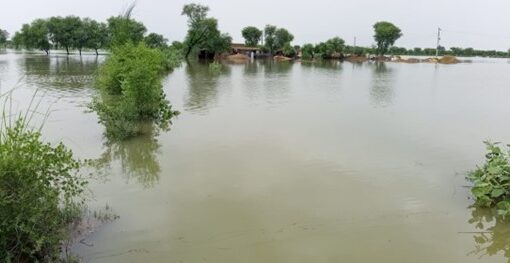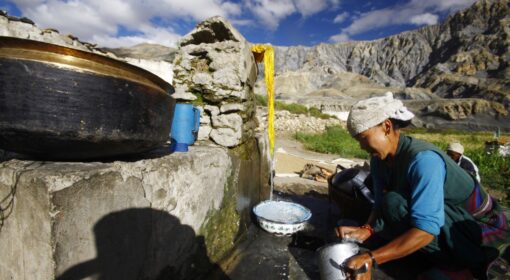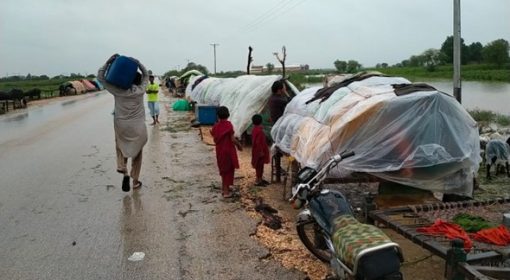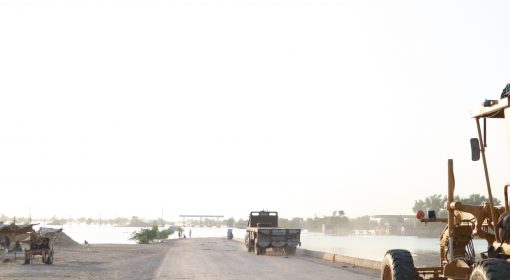By Muhammad Ehsan Laghari

We’ve barely emerged from the Indus River water scarcity for agriculture; although the flows of the Indus and Kabul have decreased in recent days, there’s still water in the dams, and this shortage can be managed until flows increase again. Now, it’s time to focus on preparing for the upcoming rains and floods. Forecasts indicate that rainfall in June, July, and August will be 47% above average, and with rising temperatures, the possibility of floods cannot be ruled out.
Sindh needs to prepare for all five types of floods: fluvial floods, floods caused by heavy rainfall, urban floods, flash floods due to rapid runoff from hilly areas, and floods resulting from sea storms. Addressing all these types of floods requires clear communication, cooperation, and defined responsibilities. Today, let’s discuss floods a bit.
We must remember that the 2022 flood was neither fluvial nor caused by a sea storm. It was a pluvial and rapid flash flood. In urban areas, the devastating 2022 flood was a painful time for all of Sindh. At this moment, we not only need to prepare but also review our ongoing and past efforts to see if we’re better equipped to face a situation like 2022 now!
Pakistan is counted among the countries most affected by global climate change, and within Pakistan, Sindh is the most vulnerable to its damaging effects. The urban and non-urban floods of the past fifteen years have clearly exposed the shortcomings in our infrastructure and disaster management. This means we’re well aware of our structural, non-structural, institutional, and governance-related issues. The lesson from the recent experience of 2022 was to manage floods with integrated management and better governance. This requires a clear roadmap of what should be done, and more importantly, what should not be done!
The widespread problem of urban flooding in Sindh is a testament to our inadequate drainage systems and our cities’ limited capacity to withstand heavy rainfall. We repeatedly see how newly constructed roads crumble during the first heavy rain. Hospitals and schools, which should serve as emergency shelters during such times, often turn into water pools, rendering them dysfunctional. A fundamental question arises here: what’s the purpose of public infrastructure works, and what should be their minimum service life? At what rainfall intensity should they break down or not? What if they break down precisely when they’re needed most? For example, a school building shouldn’t just be a physical structure; it should provide a safe, functional, and climate-resilient environment for our children to learn and thrive. When it fails to do so, it reveals a deep gap in our planning and implementation.
Some significant structural works have been undertaken in the post-2022 flood reconstruction efforts. Steps taken for the Left Bank Outfall Drain (LBOD) system, such as connecting “Pran” flows through siphons, strengthening the LBOD, and constructing regulators to divert excess water to Shakoor Lake, are undoubtedly commendable. The significant increase in the capacity to discharge water from Manchar Lake – from just 10,500 cusecs to 50,000 cusecs – is a positive development that will help manage large volumes of water.
These efforts, though necessary and important, are hampered by several challenges. For instance, land acquisition issues for widening passages obstruct crucial works like widening the Hakra Dhoro near New Kot. The dangerous encroachment of urban settlements and agricultural lands on historical riverbeds and natural waterways exacerbates the problem, effectively blocking vital routes for floodwater. Furthermore, the incomplete Right Bank Outfall Drain (RBOD) project continues to weaken our right bank of the river, perhaps awaiting the next major flood.
So, are we really better prepared now than in 2022? While we might be better and more confident in terms of actions and discussions, a comprehensive and definitive “yes” is still missing. Our driving force has always been, and continues to be, structural works. These are necessary, but they’re not sufficient! Attention must also be paid to non-structural measures: fundamental institutional capacity, transparent governance, overall institutional improvement, long-term planning, at least reducing the “elephant in the room” of corruption to the size of a goat, inter-institutional cooperation, practical implementation of plans, listening to people’s suggestions, learning from global experiences, focusing on science and research, learning from our mistakes, and taking proactive steps instead of reactive ones. Many of these actions might not even require money; however, for some, personal gains might decrease!
We’ve observed that not only developed but also developing nations have progressed. Global understanding has shifted towards “living with floods,” giving rivers their natural space, building low-lying dikes to allow water to spread, and adopting a comprehensive approach/philosophy to water management. This is a transformation we desperately need.
There are genuine flaws in our governance. Reports from international organizations like the World Bank and IMF consistently highlight issues in developing nations, including weak project selection, design, cost estimation, and the prevalence of personal gain over public benefit. Furthermore, even well-designed projects often lose their functionality and utility due to a lack of adequate maintenance funding and political and administrative prioritization.
Consider the fundamental questions that continuously plague us: Why does Hyderabad’s Autobhan Road repeatedly collapse? Why do stones emerge from our roads after just a few days of rain? Why do hospitals and schools in important areas of some cities always get inundated? Why do countless government projects remain incomplete despite huge expenditures? Why do we keep layering stones upon stones on roads, constantly turning our homes, streets, and shops into flood-prone areas?
The answers to these questions are often open secrets: a persistent lack of quality, widespread capacity deficits, pervasive and collectively accepted corruption, inadequate planning, and a complete failure of the accountability system. Our infrastructure, in both quality and quantity, has unfortunately remained stagnant. This clearly indicates that our methods, institutions, and practical steps are not leading towards a “sustainable infrastructure system.”
For urban flooding, we can learn from Bangladesh, India, or other similar countries, how they’ve made significant progress in urban flood management through robust drainage and stormwater management. Their proactive approach to urban resilience, including comprehensive planning and infrastructure improvements, offers a clear example of what can be achieved with sustained commitment.
Crucial Steps for Flood Resilience
To build genuine resilience against urban and non-urban floods in Sindh, several crucial and decisive steps are necessary:
Prioritize Quality and Durability: All new infrastructure projects, whether roads, drainage systems, schools, or hospitals, must be constructed to high standards, with special attention to long-term durability and resilience against climate change. This means prioritizing robust construction over short-term solutions.
Strengthen Institutional Governance: We must implement transparent, accountable, and efficient infrastructure governance frameworks. This should encompass the entire lifecycle of a development project, from initial planning and design to detailed practical implementation, and, most importantly, continuous maintenance! The current system, where projects are often designed to benefit special interests rather than public needs, must be dismantled.
Reduce Corruption: The time has come to remove the dead dog from the well instead of drawing forty buckets of water to purify it. This social malaise must be openly discussed politically, socially, and institutionally to find ways to mitigate it. The cost of this corruption is not just financial; it’s measured in human suffering, economic losses, hindered development, and increased poverty.
Invest in Maintenance: Repair and maintenance of existing infrastructure must be a national priority and adequately funded. It’s an undeniable fact that a large portion of new projects wouldn’t be necessary if existing infrastructure were properly maintained. Maintenance work should be given priority, respect, budget, and transparency; the annual performance of institutional heads and secretaries should also be linked to maintenance performance. Doing so could reduce the need for 50% of major new construction projects.
Adopt Integrated Flood Management: Our approach to floods must go beyond merely strengthening embankments. It includes:
- Give Rivers Space: Allow rivers to utilize their natural paths and wider floodplains during high flows, limiting construction in these critical areas.
- Proactive Measures: Actively relocate settlements and agricultural lands from old riverbeds and natural waterways that are crucial for spreading and channeling floodwaters.
- Widen Bridges: Widen bridges over rivers to improve water flow and reduce pressure on upstream embankments.
- Complete Incomplete Projects: Rapidly complete crucial, long-pending projects like RBOD, designing and implementing them according to international standards with expert assistance.
- Enhance Community Involvement: Genuine public participation in planning and implementation is essential. When communities are involved, projects are more likely to meet their needs and be effectively maintained. This also fosters a sense of ownership and shared responsibility.
- Capacity Building: Enhance the technical and managerial capacities of all institutions and contractors involved in infrastructure development and disaster management. Professional capacity and expertise are indispensable. Some of these important recommendations have also been given to us by friendly countries and organizations, such as the government of the Netherlands and Japan’s JICA.
We stand at a critical juncture. We must now collectively adopt transparent governance, quality infrastructure, and a comprehensive approach to flood resilience. Only then can we protect our people and our future from the recurring devastation of floods and put Sindh on a path of sustainable development.



